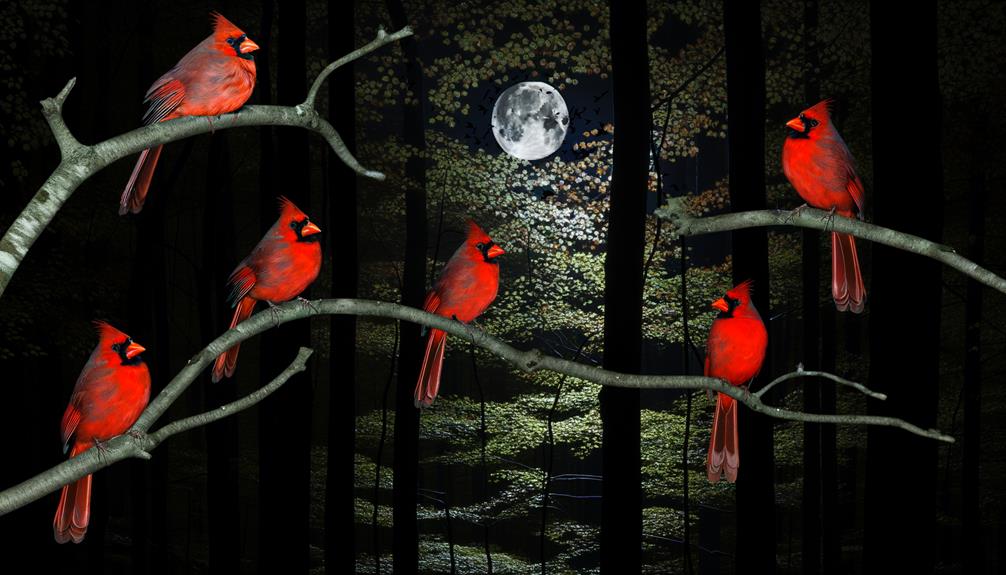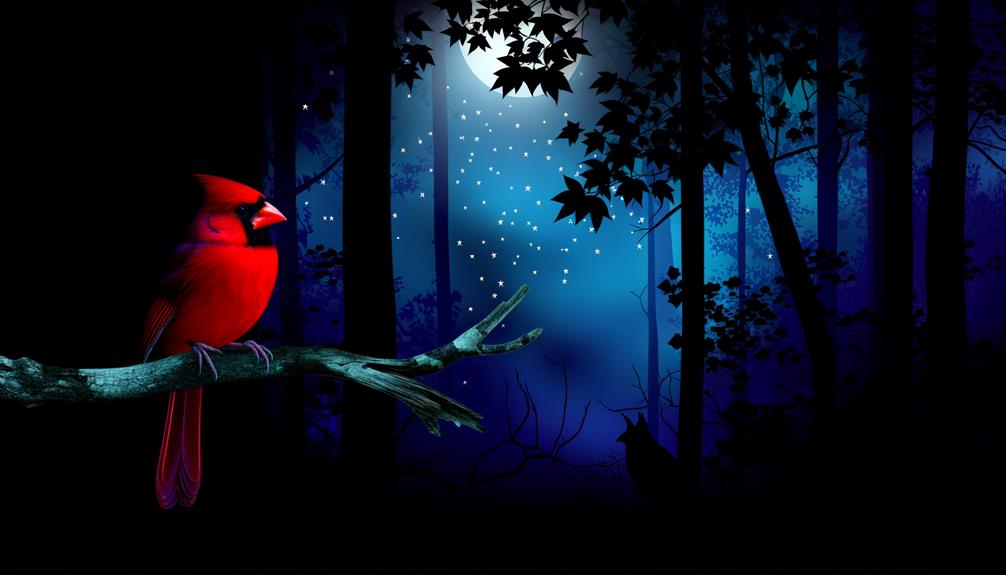Do Cardinals Fly at Night?
Cardinals don't typically fly at night. They're diurnal, meaning they're active during the day, especially at dawn and dusk.
Their sharp vision is crucial for locating food, which isn't effective in low light. At night, they seek shelter in dense shrubs to stay safe from predators like owls and raccoons.
While they do have some adaptations for low light, such as rod cells in their eyes, these aren't sufficient for effective nighttime navigation. Their bright plumage also makes them easily visible to predators at night, so they avoid nighttime activity.
Stick around to explore more about their fascinating behaviors.

Key Takeaways
- Cardinals are diurnal and rarely fly at night due to poor night vision.
- They seek shelter in dense foliage or thickets at night to avoid predators.
- Nighttime navigation is risky for cardinals, increasing their vulnerability to nocturnal threats.
- Their natural sleep patterns align with the light cycle, making nighttime activity uncommon.
- Limited night vision and heightened predatory risks deter cardinals from flying after dark.
Cardinal Behavior Overview

To understand whether cardinals fly at night, you first need to explore their general behavior patterns, which are primarily diurnal. Cardinals are most active during the day, particularly at dawn and dusk. They exhibit behaviors like foraging for food, singing to mark territory, and engaging in social interactions.
With sharp vision adapted for daylight, they rely on sight to locate seeds, insects, and fruits. Their bright red plumage helps them stand out in dense foliage, aiding in both mating and territorial displays.
At night, cardinals seek shelter in dense shrubs or trees to avoid predators. This diurnal nature suggests they don't typically fly at night, aligning their activities with the availability of light and safety.
Daily Activity Patterns
Cardinals demonstrate a clear pattern of daily activities, with peak periods of foraging and social interaction occurring mainly at dawn and dusk. You'll notice that these vibrant birds are most active during the early morning and late afternoon, maximizing their interaction when visibility and temperature are at their best.
During these times, they search for seeds, fruits, and insects, providing essential energy for their high metabolism. They also engage in singing, important for marking territory and attracting mates.
Midday hours are typically spent resting or preening in shaded areas to avoid the heat. By understanding these patterns, you can better appreciate their behaviors and the natural rhythms that govern their lives, offering a glimpse into their fascinating daily routines.
Nighttime Vision Capabilities

You should know that cardinals have specific adaptations for low light conditions, but their vision isn't as effective at night as it is during the day. Their retinas contain more rod cells, enhancing their ability to see in dim light, yet not sufficient for complete nocturnal activity.
Comparing day versus night vision, cardinals rely heavily on daylight to navigate and find food.
Adaptations for Low Light
Although cardinals are primarily diurnal, their eyes contain a higher number of rod cells compared to cone cells, enhancing their ability to detect movement and navigate in low light conditions. These adaptations allow them a degree of nocturnal activity when necessary.
You might find it fascinating to understand these mechanisms:
- Rod Cells: These cells are highly sensitive to light, allowing cardinals to see in dim conditions.
- Tapetum Lucidum: A reflective layer behind the retina that improves night vision.
- Wide Field of View: Larger eyes offer a broader view, essential for spotting predators or food.
- Neural Adaptations: Specialized brain regions process low-light visual information efficiently.
These adaptations grant cardinals a surprising level of agility and freedom in low-light environments.
Comparing Day Vs. Night
When comparing daytime and nighttime vision capabilities, it's evident that the rod cells in a cardinal's eyes play a pivotal role in enhancing their nocturnal vision.
By focusing on these specialized photoreceptor cells, you can understand how cardinals perceive their surroundings in low light. Rod cells, more sensitive to dim light than cone cells, allow the bird to detect movement and shapes during the night.
This adaptation doesn't mean cardinals are as active at night as during the day, but it does grant them a degree of freedom to navigate and forage when necessary.
You'll find that while their daytime vision relies on cone cells for color detection, the rod cells take over as light levels drop, optimizing their survival.
Predators and Night Risks
You should consider the significant threats cardinals face from nocturnal predators like owls and raccoons. Cardinals' bright plumage makes them more visible at night, increasing their risk of being spotted.
Additionally, their limited nighttime navigation skills can lead to dangerous encounters and impede their ability to escape threats.
Nocturnal Predator Threats
Due to the increased activity of nocturnal predators such as owls and raccoons, cardinals face significant threats if they venture out during the night. These predators are highly adapted to the dark, making nighttime perilous for cardinals.
You should consider the following risks:
- Owls: With exceptional night vision and silent flight, owls can easily catch unsuspecting cardinals.
- Raccoons: These cunning mammals are adept climbers and can reach nests, preying on both adult cardinals and their eggs.
- Cats: Domestic and feral cats roam at night, posing a constant threat with their stealth and agility.
- Snakes: Some snake species hunt at night, targeting nests and roosting birds.
Understanding these risks highlights why cardinals prefer the safety of daylight.
Cardinal Visibility Issues
Cardinals face heightened risks at night due to their bright plumage, which makes them more visible to nocturnal predators. Their vivid red feathers stand out in low light, increasing their chances of being spotted by owls, raccoons, and other nighttime hunters.
This heightened visibility can lead to higher predation rates, posing a significant threat to their survival. To mitigate these risks, cardinals prefer to remain hidden in dense foliage or thick shrubbery after dusk. By doing so, they're less likely to attract unwanted attention.
It's essential to understand that while cardinals have adapted to some extent, their striking appearance remains a double-edged sword, offering beauty by day but danger by night. Embrace their resilience but recognize their nighttime vulnerabilities.
Nighttime Navigation Challenges
Wandering through the night, these birds encounter numerous challenges, primarily from predators like owls and raccoons that exploit their limited nocturnal vision and conspicuous plumage. It's a perilous journey where every shadow holds potential danger.
You should understand that cardinals face several specific risks:
- Owls: Silent hunters with excellent night vision, they can easily spot and snatch cardinals.
- Raccoons: Agile climbers that can raid nests, posing a constant threat.
- Navigation Errors: Cardinals' poor night vision leads to collisions and disorientation.
- Exposure: Their bright red feathers make them easy targets under moonlight.
Understanding these risks highlights the bravery of these birds and underscores the precariousness of their nighttime flights. Freedom is a flight fraught with danger.
Sleep Habits of Cardinals

Observations indicate that Northern Cardinals exhibit diurnal behavior, meaning they're primarily active during daylight hours and seek shelter to sleep at night.
You'll find that these birds prefer dense foliage or thickets to roost, providing them with protection from predators. They typically choose locations that are well-hidden and offer a stable temperature.
Cardinals exhibit a strong sense of territoriality, often returning to the same sleeping spots. Their sleep patterns align with the natural light cycle, waking at dawn to feed and sing.
Migration and Night Flights
While many bird species undertake nocturnal migrations, Northern Cardinals are largely non-migratory and rarely engage in night flights. Their sedentary nature keeps them within a consistent territory year-round.
You might wonder why these vibrant birds don't join the nocturnal migration wave. Here's why:
- Stable Food Sources: Cardinals have access to seeds and insects throughout the year, eliminating the need to migrate.
- Adaptability: They thrive in various climates, from the cold winters of the north to the warmer southern states.
- Territorial Behavior: Cardinals are fiercely territorial, preferring to defend their home rather than venture into the unknown.
- Energy Conservation: Staying put helps them conserve energy for breeding and raising their young.
Understanding these factors emphasizes the cardinals' unique and steadfast lifestyle.
Nocturnal Instincts

You should consider cardinals' natural sleep patterns, which align with their diurnal nature, making nighttime activity rare.
Their awareness of predatory risks also discourages nocturnal flights, as night hunters are more active then.
Additionally, cardinals have limited night vision, further reducing their likelihood of flying after dark.
Natural Sleep Patterns
Cardinals, like most diurnal birds, have natural sleep patterns that align with daylight, relying on their instincts to find safe roosting spots during the night. You'll find them nestled in dense foliage or sheltered branches, where they remain vigilant and protected. Their circadian rhythms ensure they're active when it's light and resting when it's dark.
Consider the following:
- Adaptation: Cardinals' sleep patterns evolved to maximize survival.
- Restoration: Nighttime rest is essential for their energy and health.
- Vigilance: Even in sleep, they remain partially alert to threats.
- Shelter: Finding the right roosting spot is crucial for safety.
Understanding these patterns helps you appreciate how cardinals navigate their world with precision and resilience.
Predatory Risks Awareness
Even in the stillness of night, a cardinal's acute instincts remain on high alert to detect potential predators lurking in the darkness.
You'd be amazed at how these birds have evolved to protect themselves when the sun sets. Their heightened sense of hearing allows them to pick up on subtle rustlings and movements, alerting them of nearby threats.
Cardinals also rely on their keen sense of smell to detect predators like owls and raccoons. By staying watchful, they manage to evade many nocturnal dangers.
This predatory risk awareness secures their survival, enabling them to continue thriving even when they're at their most vulnerable.
Limited Night Vision
Despite their remarkable adaptability, cardinals possess limited night vision, relying primarily on their well-honed nocturnal instincts to navigate and survive in the dark. Their eyes lack the specialized structures found in nocturnal birds, making night flights risky. However, their instincts help them find safe spots to roost and conserve energy until dawn.
You might be surprised by how these elements work together to guarantee survival:
- Heightened auditory senses – They listen keenly for predators and environmental cues.
- Memorized landscapes – Cardinals remember familiar terrain, aiding in safe navigation.
- Instinctual stillness – They remain motionless to avoid drawing attention.
- Group behavior – They often roost together, enhancing safety through numbers.
Appreciate the delicate balance cardinals maintain to thrive despite their visual limitations.
Environmental Influences
Weather conditions play an essential role in determining whether cardinals are active during nighttime hours. You'll find that these birds are highly sensitive to changes in temperature, wind, and precipitation.
Cold temperatures can deter them from nighttime activity due to the increased energy required to maintain body heat. Strong winds make flying difficult and dangerous, while heavy rain can reduce their ability to navigate.
Additionally, moonlight can influence their behavior; a bright, moonlit night might encourage some movement due to improved visibility. However, cardinals generally prefer to roost in dense foliage for protection.
Understanding these environmental factors can help you appreciate why cardinals typically avoid nighttime flights, seeking shelter and safety instead.
Research and Studies

Numerous scientific studies have explored the nocturnal behaviors of cardinals, shedding light on their activity patterns and the factors influencing their nighttime movements. Researchers have used various methods, including radio tracking and infrared cameras, to observe these vibrant birds after dark. The findings reveal intriguing insights:
- Limited Night Flights: Cardinals typically avoid flying at night, preferring daytime activity.
- Predator Avoidance: Darkness increases vulnerability to nocturnal predators, influencing their decision to stay grounded.
- Feeding Habits: They usually forage during the day, reducing the need for nighttime movement.
- Artificial Light Impact: In urban areas, artificial lighting can slightly alter their behavior.
You're now equipped with a deeper understanding of how cardinals navigate their nocturnal environment, balancing survival and freedom.
Comparing With Other Birds
When comparing cardinals to other bird species, you'll find that many birds exhibit unique nocturnal behaviors that differ substantially from the cardinal's daytime activity patterns.
For instance, owls and nighthawks are classic nocturnal birds, using the cover of darkness to hunt and navigate. Unlike cardinals, which are diurnal and rely on daylight for feeding and social interaction, these nocturnal birds have evolved specialized adaptations such as enhanced night vision and exceptional hearing.
Additionally, some migratory songbirds travel at night to avoid predators and conserve energy. Even certain waterfowl, like ducks, may engage in nocturnal foraging. Understanding these differences highlights the diverse strategies birds adopt to thrive in their environments, making each species uniquely adapted to its ecological niche.
Observing Cardinals at Night

To observe cardinals at night, you'll need to understand their nocturnal behavior patterns and the environmental factors that influence their activity. Cardinals are diurnal birds, meaning they're most active during the day. However, they may occasionally fly at night due to disturbances or in search of food.
To maximize your chances of observing them:
- Use low-intensity red lights: These minimize stress and avoid startling the birds.
- Provide nighttime feeders: Ensuring a food source might attract cardinals if they venture out.
- Listen for calls: Cardinals may communicate with soft chirps even at night.
- Choose moonlit nights: Increased visibility during full moons can make cardinal sightings more likely.
Understanding these factors can help you enjoy a rare glimpse of these beautiful birds at night.
Conclusion
You'd think cardinals, with their striking red plumage, would be the rockstars of the night, right?
Ironically, they're more like homebodies, settling in for a good night's sleep instead of dazzling under the moonlight.
Despite their excellent daytime vision, they avoid nighttime activities due to poor night vision and high predator risks.
While other birds might brave the dark, cardinals prefer the safety of their roosts.
So, if you're hoping for a nocturnal cardinal concert, you're out of luck!






